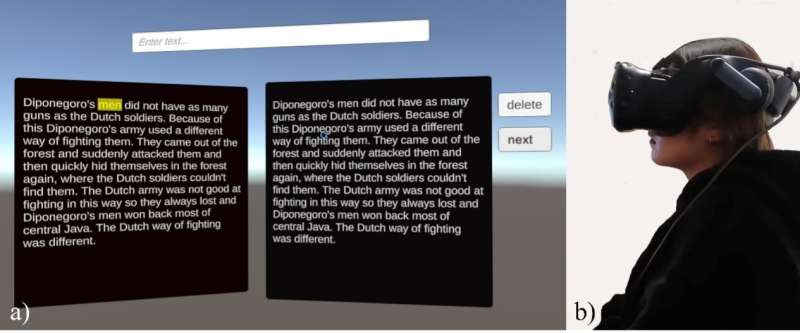
Virtual reality (VR) and augmented reality (AR) head-mounted displays allow users to experience digital content in more immersive and engaging ways. To keep the users as immersed in the content as possible, computer scientists have been trying to develop navigation and text selection interfaces that do not require the use of their hands.
Instead of pressing buttons on a manual controller, these interfaces would allow users to select texts or perform commands simply by moving their heads or blinking their eyes. Despite the promise of these approaches, today most head-mounted displays still heavily rely on handheld controllers or hand and finger gestures.
Researchers at Xi’an Jiaotong-Liverpool University and Birmingham City University have recently carried out a study aimed at investigating different hands-free text selection approaches for VR and AR headsets. Their findings, published in a paper pre-published on arXiv, highlight the benefits of some of these approaches, particularly those that enable interactions through eye blinks.
“My group has been engaged in improving text entry for VR/AR over the past six years,” Hai-Ning Liang, one of the researchers who carried out the study, told TechXplore. “Text entry is an important element in the ecosystem of text entry and editing.”
The recent study by Liang and his colleagues builds on some of their previous research focusing on hands-free text entry techniques for VR. In their previous studies, the team found that hands-free techniques could simplify user interactions with VR systems, making entering text more intuitive.
“The main goal of our work is to explore what types of features are suitable for hands-free text selection in VR,” Liang explained. “In this new study, we investigated the potential of hands-free text selection approaches in a controlled lab experiment with 24 participants using a within-subjects experiment design (i.e., where the participants experienced all test conditions).”
In their experiments, Liang and his colleagues asked participants to test different text selection methods while performing a specific task. This task mimicked what the users might encounter in real-world settings while using VR and was divided into three conditions that varied based on the length of the text presented to users (i.e., short: single word; medium: 2–3 lines of text; long: 6–8 lines of text).

The participants were asked to use different hands-free text selection methods while in a VR reading environment that the team had specifically created for the experiment. After they completed these tests, the participants were asked to provide feedback about their experiences.
“Text selection, like many other interactions in VR, requires a pointing mechanism for the identification of the objects to be selected prior to interacting with them, and then another mechanism to indicate the selection,” Liang said. “In this study, we selected head-based pointing as our pointing mechanism, which means the cursor will follow the user’s head movements.”
Liang and his colleagues decided to specifically assess the potential of three different text selection methods, referred to as “Dwell,” “Eye blinks” and “Voice.” Dwell requires users to hover the pointer on the area where the text they want to select is located for a specific time (e.g., 1 second).
When using the Eye blinks for selection, users were asked to intentionally blink their eyes to select a specific text. Their system recognizes these intentional eye blinks because they are typically longer than natural ones (approximately 400ms instead of 100–200ms).
Finally, the Voice approach required users to produce a sound over 60db. In their experiments, the researchers asked their participants to make a humming sound when they wished to select a text fragment.
“These selection mechanisms, including their parameters, were chosen based on findings from the literature and a series of pilot tests we did,” Liang explained. “The findings gathered in our experiment once again confirmed that hands-free approaches could be suitable for text selection in VR. In addition, we showed that eye blinks are a very efficient and useful selection mechanism for hands-free interaction.”
The recent work by Liang and his colleagues highlights the huge potential of hands-free text selection techniques for making VR systems more intuitive and convenient to use. In the future, their findings could inspire more research teams to develop and evaluate blink-based techniques for text selection and other types of interactions.
“Our plan for future research in this area will be to focus on making text selection even more efficient and usable and integrating it into the ecosystem for text editing and document creation in VR/AR,” Liang added. “We will also be designing text selection methods that can be used by a variety of impaired users and exploring other approaches, including eye gaze for cursor movement instead of head movements.”
Do you use predictive text? Chances are it’s not saving you time, and could even be slowing you down
Xuanru Meng, Wenge Xu, Hai-Ning Liang, An exploration of hands-free text selection for virtual reality head-mounted displays. arXiv:2209.06825v1 [cs.HC], arxiv.org/abs/2209.06825
Xueshi Lu et al, Exploration of Hands-free Text Entry Techniques For Virtual Reality, 2020 IEEE International Symposium on Mixed and Augmented Reality (ISMAR) (2020). DOI: 10.1109/ISMAR50242.2020.00061
Xueshi Lu et al, iText: Hands-free Text Entry on an Imaginary Keyboard for Augmented Reality Systems, The 34th Annual ACM Symposium on User Interface Software and Technology (2021). DOI: 10.1145/3472749.3474788
© 2022 Science X Network
Citation:
Study assesses the efficacy of hands-free text selection systems for VR headsets (2022, October 12)
retrieved 12 October 2022
from https://techxplore.com/news/2022-10-efficacy-hands-free-text-vr-headsets.html
This document is subject to copyright. Apart from any fair dealing for the purpose of private study or research, no
part may be reproduced without the written permission. The content is provided for information purposes only.
Stay connected with us on social media platform for instant update click here to join our Twitter, & Facebook
We are now on Telegram. Click here to join our channel (@TechiUpdate) and stay updated with the latest Technology headlines.
For all the latest Technology News Click Here
